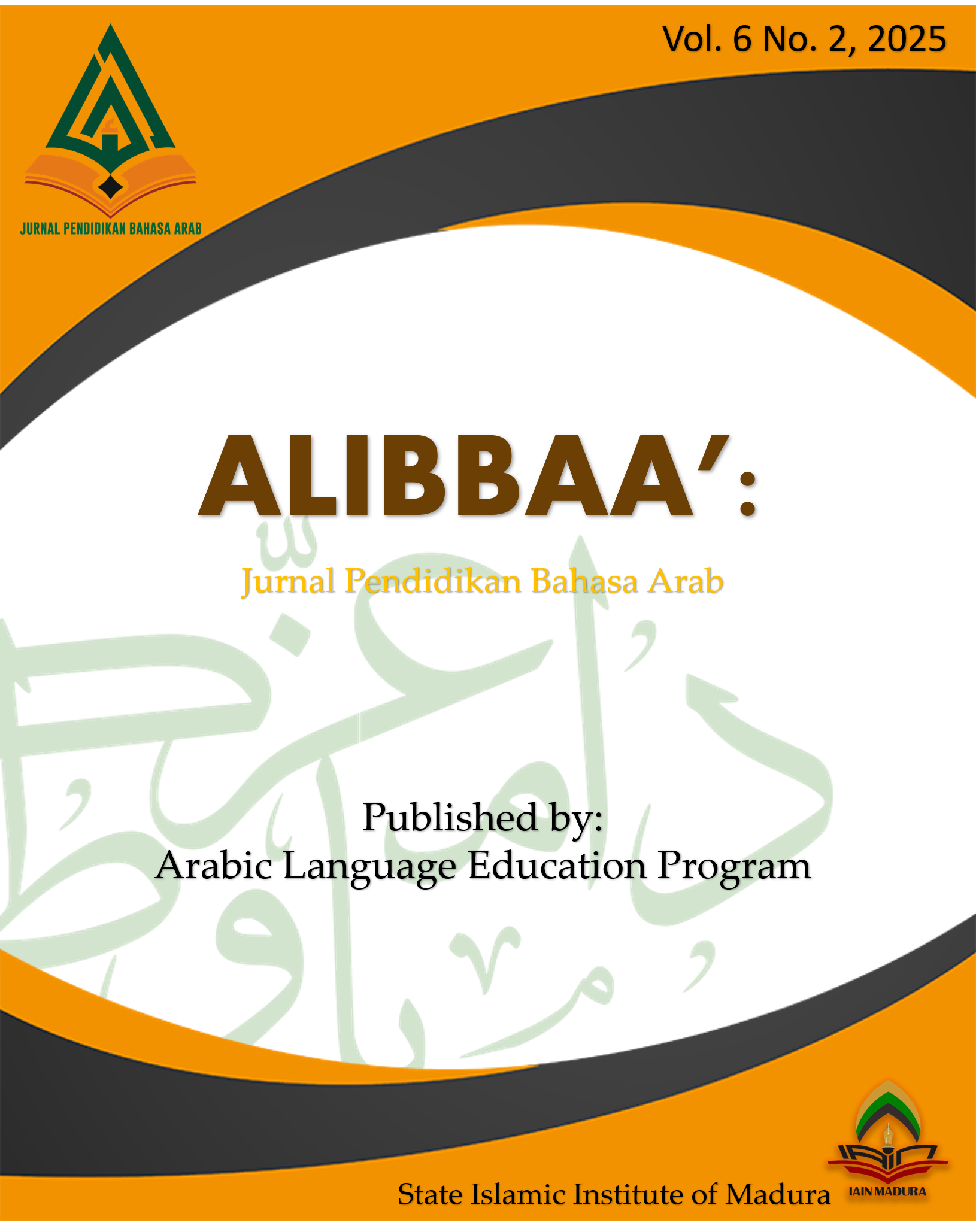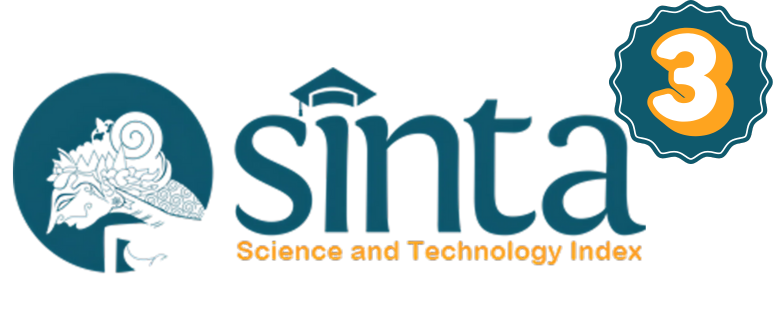Designing Visually-Enriched Arabic Vocabulary Instruction Using Canva: Empirical Evidence from a Pre-Experimental Study in an Indonesian Islamic Secondary School
 Abstract views: 193
,
Abstract views: 193
,
 pdf downloads: 174
pdf downloads: 174
Abstract
This study aims to examine the effect of Canva-based representative visual media on improving Arabic vocabulary mastery among seventh-grade students at MTs Negeri 2 Medan. Initial classroom observations indicated low vocabulary retention and diminished student motivation, largely due to monotonous instructional methods and limited use of visual learning media. To address these challenges, Canva-based visual media were implemented as an instructional intervention. The study employed a quantitative approach using a pre-experimental design (one-group pretest-posttest). Data analysis involved both descriptive and inferential statistics, specifically utilizing the paired sample t-test with the aid of SPSS. The findings revealed a significant increase in the mean score from 45.42 (pretest) to 81.03 (posttest), with a gain of 35.61 points. A significance value of 0.001 < 0.05 confirmed that the use of Canva-based visual media had a statistically significant impact on students’ Arabic vocabulary acquisition. These findings imply that the integration of digital visual media should be seriously considered in the design of Arabic language instruction at the secondary school level.
Downloads
References
Alfiana, Muhammad, Bayu Rima Aditya, Elis Hernawati, Pikir Wisnu Wijayanto, and Tedi Gunawan. “Usability Testing of the Canva Application As a Student Collaboration Design Media.” In 2023 8th International Conference on Information Technology and Digital Applications (ICITDA), 1–5. IEEE, 2023. https://doi.org/10.1109/ICITDA60835.2023.10427037.
Annafiri, Ahmad Zaki, Andi Suseno, Ilmah Fitrotul Azizah, Ahmad Mizaj El Kafoor, and Firda Saphira Azzahro. “Cultural Analysis of the Arabic Language Textbooks of Muhammadiyah Elementary School.” Alibbaa’: Jurnal Pendidikan Bahasa Arab 5, no. 1 (January 30, 2024): 98–119. https://doi.org/10.19105/ajpba.v5i1.10989.
Clark, James M., and Allan Paivio. “Dual Coding Theory and Education.” Educational Psychology Review 3, no. 3 (September 1991): 149–210. https://doi.org/10.1007/BF01320076.
Darvin, Ron, and Bonny Norton. “Investment and Motivation in Language Learning: What’s the Difference?” Language Teaching 56, no. 1 (January 15, 2023): 29–40. https://doi.org/10.1017/S0261444821000057.
Dmitrenko, Natalia, Iryna Shkola, Bohdana Saliuk, Violetta Panchenko, and Svitlana Neshko. “CANVA PLATFORM: VISUAL CONTENT FOR DEVELOPING WRITING SKILLS OF PROSPECTIVE ENGINEERS IN ESP CLASSES.” ENVIRONMENT. TECHNOLOGIES. RESOURCES. Proceedings of the International Scientific and Practical Conference 2 (June 22, 2024): 358–63. https://doi.org/10.17770/etr2024vol2.8075.
Fakhrur Rashih. “تعليم المفرادات للناطقين بغير اللغة العربية.” Lisanudhad: Jurnal Bahasa, Pembelajaran Dan Sastra Arab 1, no. 2 (2014): 25–38.
Haniff Mohd Tahir, Mohd, Intan Safinas Mohd Ariff Albakri, Airil Haimi Mohd Adnan, Mohamad Syafiq Ya Shaq, and Dianna Suzieanna Mohamad Shah. “The Application of Visual Vocabulary for ESL Students’ Vocabulary Learning.” Arab World English Journal 11, no. 2 (June 15, 2020): 323–38. https://doi.org/10.24093/awej/vol11no2.23.
Hasibuan, Renni, Mamluatul Hasanah, and Faisol. “Improving Balaghah Mastery Through Teams Games Tournaments with Crossword Puzzle Media in Higher Education.” Al-Lisan 9, no. 1 (February 29, 2024): 33–50. https://doi.org/10.30603/al.v9i1.4520.
Hinchcliff, Mercedez, and Michael Mehmet. “Embedding Canva into the Marketing Classroom: A Dialogic and Social Learning Approach to Classroom Innovation.” Higher Education, Skills and Work-Based Learning 13, no. 6 (November 8, 2023): 1174–86. https://doi.org/10.1108/HESWBL-11-2022-0230.
Huda, Nurul, Isnaini Maulidia Annisa, and Muhammad Nuruzzaman Syam. “Writing Skills Teaching Methods for Elementary School Students: Scramble in Connecting Arabic Letters.” Alibbaa’: Jurnal Pendidikan Bahasa Arab 5, no. 2 (August 7, 2024): 268–87. https://doi.org/10.19105/ajpba.v5i2.15084.
Ilyas, Muhammad, Hermawati Syarif, and Refnaldi. “The Use of English Language Learning Videos Designed Through Canva App: Students’ Perceptions.” International Journal of Interactive Mobile Technologies (IJIM) 17, no. 08 (April 26, 2023): 100–112. https://doi.org/10.3991/ijim.v17i08.39215.
Jamil, Husnaini, and Nur Agung. “Tantangan Pembelajaran Bahasa Arab Di Era Society 5.0: Analisis Pembelajaran Bahasa Arab Berbasis Aplikasi Interaktif.” Alibbaa’: Jurnal Pendidikan Bahasa Arab 3, no. 1 (January 24, 2022): 38–51. https://doi.org/10.19105/ajpba.v3i1.5536.
Khoirul Mubin, Nasiruddin, Boby Bagas Purnama, and Dionisia Folliero. “Linguistic Harmonization: Dissecting Alfiyah Ibn Malik with Chomsky’s Transformational Generative Theory.” Alibbaa’: Jurnal Pendidikan Bahasa Arab 5, no. 2 (July 31, 2024): 215–42. https://doi.org/10.19105/ajpba.v5i2.14610.
Khuluq, Muchsinul, Mamluatul Hasanah, Muasshomah Muasshomah, and Nurul Imamah. “Mobile-Assisted Language Learning Apps: The Analysis of Duolingo.” Al-Ta’rib : Jurnal Ilmiah Program Studi Pendidikan Bahasa Arab IAIN Palangka Raya 12, no. 2 (December 5, 2024): 229–46. https://doi.org/10.23971/altarib.v12i2.8806.
Little, Todd D., Rong Chang, Britt K. Gorrall, Luke Waggenspack, Eriko Fukuda, Patricia J. Allen, and Gil G. Noam. “The Retrospective Pretest–Posttest Design Redux: On Its Validity as an Alternative to Traditional Pretest–Posttest Measurement.” International Journal of Behavioral Development 44, no. 2 (March 21, 2020): 175–83. https://doi.org/10.1177/0165025419877973.
Liu, Guangxiang, and Chaojun Ma. “Measuring EFL Learners’ Use of ChatGPT in Informal Digital Learning of English Based on the Technology Acceptance Model.” Innovation in Language Learning and Teaching 18, no. 2 (March 14, 2024): 125–38. https://doi.org/10.1080/17501229.2023.2240316.
Liu, Yuying, Freda Mishan, and Angela Chambers. “Investigating EFL Teachers’ Perceptions of Task-Based Language Teaching in Higher Education in China.” The Language Learning Journal 49, no. 2 (March 4, 2021): 131–46. https://doi.org/10.1080/09571736.2018.1465110.
Mayer, Richard E. “Multimedia Learning,” 85–139, 2002. https://doi.org/10.1016/S0079-7421(02)80005-6.
Meletiadou, Eleni. “Using Educational Digital Storytelling to Enhance Multilingual Students’ Writing Skills in Higher Education.” IAFOR Journal of Education 10, no. 2 (August 27, 2022): 111–30. https://doi.org/10.22492/ije.10.2.06.
Mohzana, Mohzana. “Evaluation of the Use of Gamification in Language Learning for Students in Indonesia.” International Journal of Language and Ubiquitous Learning 1, no. 4 (January 4, 2024). https://doi.org/10.70177/ijlul.v1i4.681.
Moro Ramos, Sandra. “Canva Como Herramienta Para Promover El Aprendizaje Significativo En La Enseñanza Del Inglés Como Lengua Extranjera.” European Public & Social Innovation Review 9 (October 2, 2024): 1–19. https://doi.org/10.31637/epsir-2024-869.
Muchsinul Khuluq, Moh. Ainin, Abdul Wahab Rosyidi, and Nurul Imamah. “The Development of Reading Skill Teaching Materials Based on Prezi Artificial Intelligence.” Arabiyatuna: Jurnal Bahasa Arab 9, no. 1 (June 31, 2025): 327–46.
Nisa’, Luthfi Farihatun, and Nurul Murtadho. “Development of Educative Magazine as a Bilingual Learning Medium Based on Arabic and English Vocabulary.” Al-Ta’rib : Jurnal Ilmiah Program Studi Pendidikan Bahasa Arab IAIN Palangka Raya 11, no. 2 (December 8, 2023): 197–212. https://doi.org/10.23971/altarib.v11i2.7311.
Nornadiah Mohd Razali, and Bee Wah Yap. “Power Comparisons of Shapiro-Wilk, Kolmogorov-Smirnov, Lilliefors and Anderson-Darling Tests .” Journal of Statistical Modeling and Analytics 2, no. 1 (2011): 21–33.
Prawijaya, Septian, Fahrur Rozi, and Arifin Siregar. “Online Learning Platform Using Canva: An Alternative Experience to Optimize the Learning Process in the Class,” 140002, 2022. https://doi.org/10.1063/5.0114111.
Salam, Muhammad Yusuf, and Adam Mudinillah. “Canva Application Development for Distance Learning on Arabic Language Learning in MTs Thawalib Tanjung Limau Tanah Datar.” JTP - Jurnal Teknologi Pendidikan 23, no. 2 (August 28, 2021): 101–11. https://doi.org/10.21009/jtp.v23i2.20650.
Saleem, Awaz Naaman, Narmin Mohammed Noori, and Fezile Ozdamli. “Gamification Applications in E-Learning: A Literature Review.” Technology, Knowledge and Learning 27, no. 1 (March 2, 2022): 139–59. https://doi.org/10.1007/s10758-020-09487-x.
Shiddiq, Jamaluddin, Ahmad Zubaidi, Muhammad Nur Kholis, and Rokhani Rokhani. “Feasibility of Web-Based Digital Arabic Gamification Media for Islamic Junior High School Students.” Arabiyatuna: Jurnal Bahasa Arab 8, no. 1 (May 27, 2024): 169. https://doi.org/10.29240/jba.v8i1.8946.
Traboco, Lisa, Haridha Pandian, Elena Nikiphorou, and Latika Gupta. “Designing Infographics: Visual Representations for Enhancing Education, Communication, and Scientific Research.” Journal of Korean Medical Science 37, no. 27 (2022). https://doi.org/10.3346/jkms.2022.37.e214.
Ulhaq, Nadia, and Lahmuddin Lubis. “Penyusunan Materi Ajar Dalam Rangka Meningkatkan Keterampilan Berbicara Bahasa Arab Pada Siswa.” Journal of Education Research 4, no. 3 (August 8, 2023): 1202–11. https://doi.org/10.37985/jer.v4i3.361.
Verawati, Anisa, Denik Agustito, Widowati Pusporini, Wikan Budi Utami, and Sri Adi Widodo. “Designing Android Learning Media to Improve Problem-Solving Skills of Ratio.” Advances in Mobile Learning Educational Research 2, no. 1 (2022): 216–24. https://doi.org/10.25082/AMLER.2022.01.005.
Yulia, Fatma, Elsayed Makki Elbishr Ali Hasan, Andini Nur Bahri, Maskanatul Fiqiyah, and Muhammad Taufiq. “Effectiveness of Instructional Communication of Mahārah Al-Kalām at Sultan Idris Education University.” Ta’lim al-’Arabiyyah: Jurnal Pendidikan Bahasa Arab & Kebahasaaraban 8, no. 2 (December 20, 2024): 216–33. https://doi.org/10.15575/jpba.v8i2.39201.
Zaimah, Nely Rahmawati, Risti Kamila Wening Estu, Syarifatul Fitri Hidayah, Syamsul Hadi, and Aiden Button. “Harnessing Gemini for Arabic Mastery: Educators’ and Learners’ Views.” Alibbaa’: Jurnal Pendidikan Bahasa Arab 5, no. 2 (July 31, 2024): 166–88. https://doi.org/10.19105/ajpba.v5i2.14808.
Zayuda, Dafa Nur Abtia, Imas Marliana, Masnida Wati Suryani, Halimah Ibrahim, and Sahkholid Nasution. “Eksistensi Mahārah Al- Kitābah Dalam Pembelajaran Bahasa Arab.” Counselia; Jurnal Bimbingan Konseling Pendidikan Islam 4, no. 2 (September 30, 2023): 164–80. https://doi.org/10.31943/counselia.v4i2.117.
Authors who publish with this journal agree to the following terms:
a. Authors retain copyright and grant the journal right of first publication with the work simultaneously licensed under a Creative Commons Attribution License that allows others to share the work with an acknowledgement of the work's authorship and initial publication in this journal.
b. Authors are able to enter into separate, additional contractual arrangements for the non-exclusive distribution of the journal's published version of the work (e.g., post it to an institutional repository or publish it in a book), with an acknowledgement of its initial publication in this journal.
c. Authors are permitted and encouraged to post their work online (e.g., in institutional repositories or on their website) prior to and during the submission process, as it can lead to productive exchanges, as well as earlier and greater citation of published work (See The Effect of Open Access).
Alibbaa': Jurnal Pendidikan Bahasa Arab have CC-BY-SA or an equivalent license as the optimal license for the publication, distribution, use, and reuse of scholarly work.
In developing strategy and setting priorities, Alibbaa': Jurnal Pendidikan Bahasa Arab recognize that free access is better than priced access, libre access is better than free access, and libre under CC-BY-SA or the equivalent is better than libre under more restrictive open licenses. We should achieve what we can when we can. We should not delay achieving free in order to achieve libre, and we should not stop with free when we can achieve libre.

Alibbaa': Jurnal Pendidikan Bahasa Arab is licensed under a Creative Commons Attribution 4.0 International License
You are free to:
- Share — copy and redistribute the material in any medium or format
- Adapt — remix, transform, and build upon the material for any purpose, even commercially.
- The licensor cannot revoke these freedoms as long as you follow the license terms.











